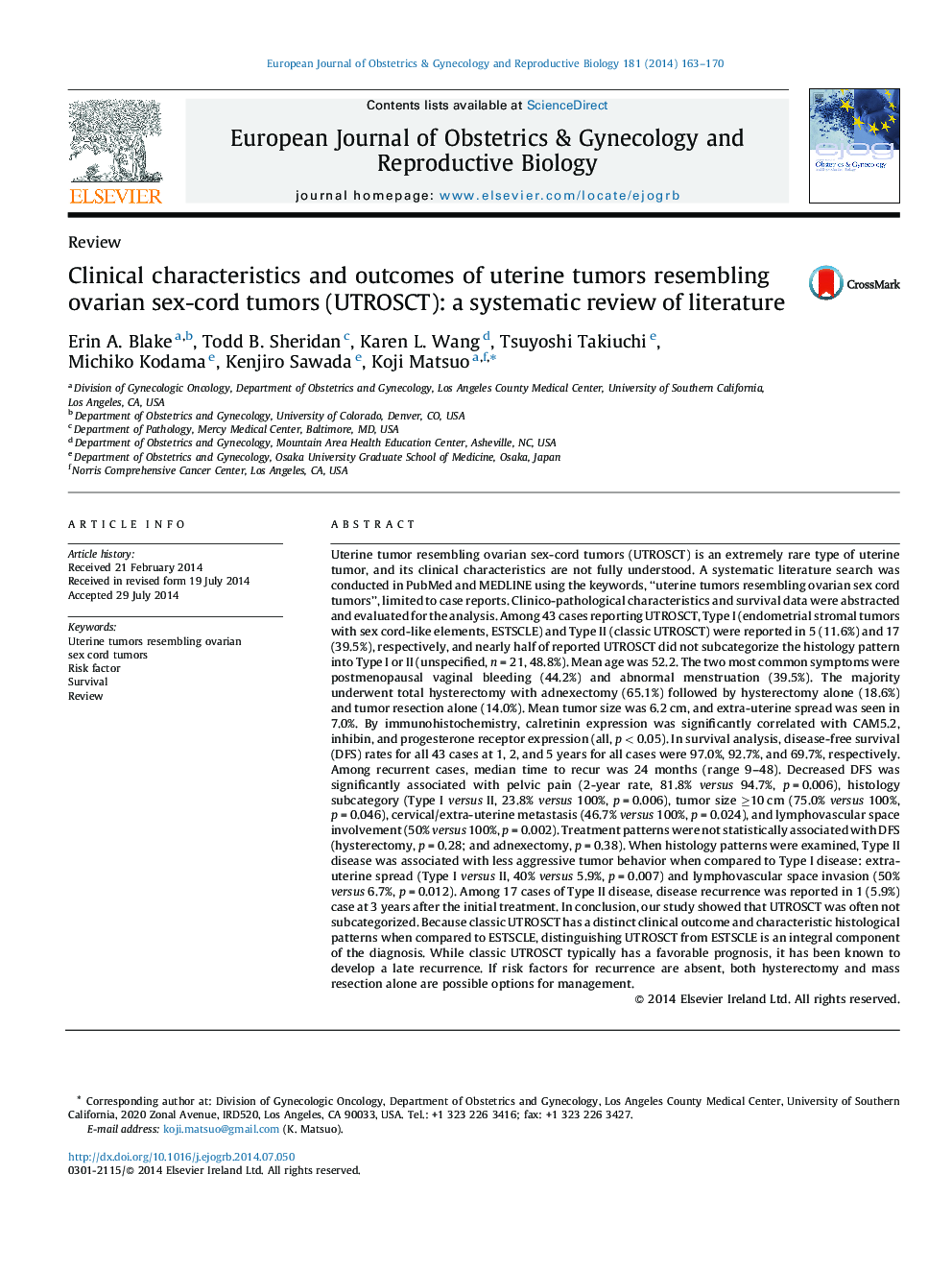| کد مقاله | کد نشریه | سال انتشار | مقاله انگلیسی | نسخه تمام متن |
|---|---|---|---|---|
| 6173201 | 1599800 | 2014 | 8 صفحه PDF | دانلود رایگان |

Uterine tumor resembling ovarian sex-cord tumors (UTROSCT) is an extremely rare type of uterine tumor, and its clinical characteristics are not fully understood. A systematic literature search was conducted in PubMed and MEDLINE using the keywords, “uterine tumors resembling ovarian sex cord tumors”, limited to case reports. Clinico-pathological characteristics and survival data were abstracted and evaluated for the analysis. Among 43 cases reporting UTROSCT, Type I (endometrial stromal tumors with sex cord-like elements, ESTSCLE) and Type II (classic UTROSCT) were reported in 5 (11.6%) and 17 (39.5%), respectively, and nearly half of reported UTROSCT did not subcategorize the histology pattern into Type I or II (unspecified, n = 21, 48.8%). Mean age was 52.2. The two most common symptoms were postmenopausal vaginal bleeding (44.2%) and abnormal menstruation (39.5%). The majority underwent total hysterectomy with adnexectomy (65.1%) followed by hysterectomy alone (18.6%) and tumor resection alone (14.0%). Mean tumor size was 6.2 cm, and extra-uterine spread was seen in 7.0%. By immunohistochemistry, calretinin expression was significantly correlated with CAM5.2, inhibin, and progesterone receptor expression (all, p < 0.05). In survival analysis, disease-free survival (DFS) rates for all 43 cases at 1, 2, and 5 years for all cases were 97.0%, 92.7%, and 69.7%, respectively. Among recurrent cases, median time to recur was 24 months (range 9-48). Decreased DFS was significantly associated with pelvic pain (2-year rate, 81.8% versus 94.7%, p = 0.006), histology subcategory (Type I versus II, 23.8% versus 100%, p = 0.006), tumor size â¥10 cm (75.0% versus 100%, p = 0.046), cervical/extra-uterine metastasis (46.7% versus 100%, p = 0.024), and lymphovascular space involvement (50% versus 100%, p = 0.002). Treatment patterns were not statistically associated with DFS (hysterectomy, p = 0.28; and adnexectomy, p = 0.38). When histology patterns were examined, Type II disease was associated with less aggressive tumor behavior when compared to Type I disease: extra-uterine spread (Type I versus II, 40% versus 5.9%, p = 0.007) and lymphovascular space invasion (50% versus 6.7%, p = 0.012). Among 17 cases of Type II disease, disease recurrence was reported in 1 (5.9%) case at 3 years after the initial treatment. In conclusion, our study showed that UTROSCT was often not subcategorized. Because classic UTROSCT has a distinct clinical outcome and characteristic histological patterns when compared to ESTSCLE, distinguishing UTROSCT from ESTSCLE is an integral component of the diagnosis. While classic UTROSCT typically has a favorable prognosis, it has been known to develop a late recurrence. If risk factors for recurrence are absent, both hysterectomy and mass resection alone are possible options for management.
Journal: European Journal of Obstetrics & Gynecology and Reproductive Biology - Volume 181, October 2014, Pages 163-170